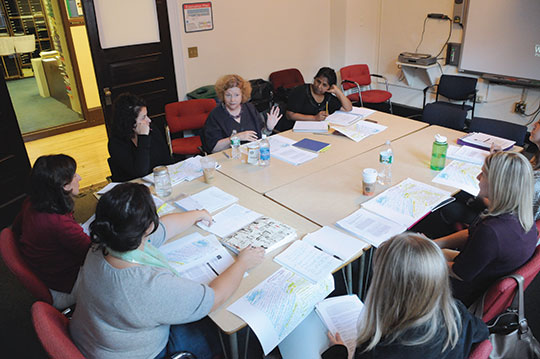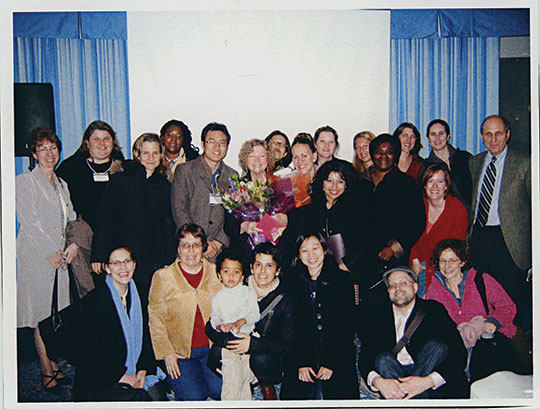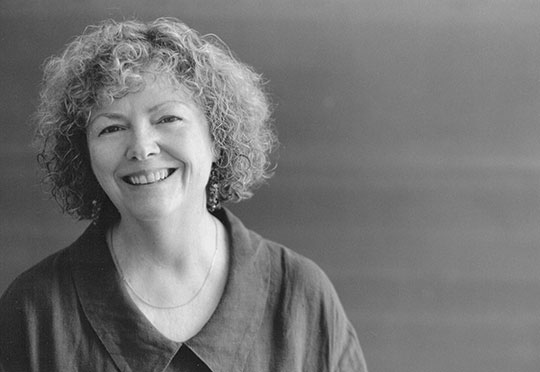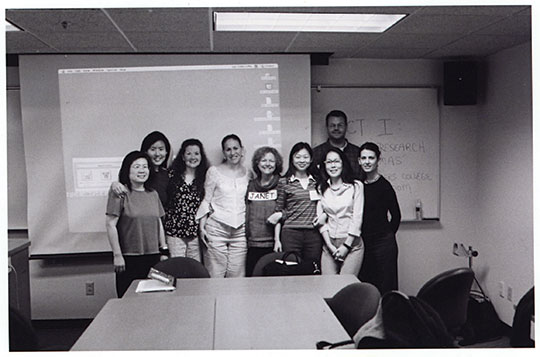The Academic Questioner
Alone and in groups, Janet Miller has devoted her career to examining constructions of identities
Alone and in groups, Janet Miller has devoted her career to examining constructions of identities
By Joe Levine
On a late summer day 25 years ago, Janet Miller invited five former students to go “beyond the formal context of our graduate classrooms…with their nailed-down seats and rigid rows” in order to “try to teach and dialogue with others in a freedom-producing way.”
What followed, recounted in Miller’s 1990 book, Creating Spaces and Finding Voices: Teachers Collaborating for Empowerment, has been described by her friend William Ayers as “something that is much discussed though rarely tried” in academia—but for Miller, groups have been not only an essential way of exploring her ideas, but an active expression of them.
Again and again during her career, Miller—Professor of English Education at TC since 2000—has stepped outside the familiar in search of “freedom-producing spaces.” On one level it has been a lonely quest—she has, by her own admission, made a habit of going off to new places where she knows no one (“I don’t recommend it”)—yet also one that has prompted her to create communities of similarly reflective souls wherever she has gone. Frequently these have been small groups of students whom Miller convenes while they are still studying with her, and who then go on to meet with her for years, even after they have scattered to jobs in other states and countries. Miller doesn’t lead these groups in any conventional sense; she works within them, often outside any regularly scheduled classes or institutional structures, on an equal footing, sometimes prodding or suggesting readings (and often generously bringing younger colleagues into her circle of influence at professional conferences). But with her long-term colleague and friend, William Pinar, Miller is also the founder of two much larger coalitions: the Journal of Curriculum Theorizing and its attendant annual Bergamo Curriculum Conference, now in its 32nd year; and the American Association for the Advancement of Curriculum Studies, for which she served as President for six years.
All of these wanderings and gatherings have been in the service of Miller’s complex and difficult brand of scholarly thought—an approach that grew out of feminism, but has since moved through labels such as phenomenology and poststructuralism. At its core is the idea that human identity is both fluid and non-unitary, framed at any given moment by race, nationality, class, gender and other interacting variables—and that this mutability calls into question how, for example, teachers and researchers can possibly ever fully and statically represent themselves or others.
“I began my academic studies in the early ’70s and am very much a result of the ’60s and its ferment,” she says. “I grew up in Pittsburgh when it was still a steel town, and I became aware very early of class distinctions—whose dads worked in the mills, whose dads didn’t. When I was doing my doctoral work at Ohio State, I was lucky enough to coincide with people who were taking up issues of power and representation, both in and through literature and classroom settings.”
During the early 1990s, Miller spent three years as part of a qualitative research team that studied several schools within the network founded by the educator Theodore Sizer, and she has since defined herself as a “teacher/researcher” who uses poststructuralist theories and qualitative, anthropological research methods to understand what goes on in K–12 classrooms as well as in collaborative groups. Her ultimate quarry is to transform teaching from the presentation of “predetermined, sequential, skills-oriented and measurable versions” of English and other subjects, into something that enables students to—in the words of her long-time friend and inspiration, Maxine Greene—look “inquiringly and wonderingly on the world.”
To get there, she passionately believes that teachers must first turn the process of inquiry upon themselves and their own autobiographical narratives.
“Through the various turns in my field, and through my own research and writing, I’ve come to realize the impossibilities of ever fully representing oneself or others,” she says. “But given that we still research, represent, analyze and discuss our data, what questions must we ask ourselves? How to pay attention to our own prejudices, assumptions, biases and habitual ways of thinking, and to the influences of dominant discourses on our own and others’ constructions of selves while still leaving oneself and one’s readers open to other interpretations? I’m as interested in the questions as the answers.”
Miller’s own rendition of such an autobiographical narrative is an essay called “Mr. Brucker’s Good Girl,” which she first published in 1992 and which is “re-narrativized” in her book Sounds of Silence Breaking: Women, Autobiography, Curriculum (2005). Initially the piece seems to describe a young girl being awakened to the possibilities of literature, class-consciousness and feminism by a charismatic sixth grade teacher, the Mr. Brucker of the title. But as the story progresses, the adult narrator reveals a more conflicted view of her teacher, her younger self and the world they are operating in. Mr. Brucker is indeed “a kind, caring and enthusiastic teacher” who “in his spontaneity…encouraged us all, girls and boys, to consider the possibilities for ourselves that did not automatically occur to many of us as we trudged home each afternoon through the hanging grayness of our steel town’s south hills.” But he is also “prized among parents and students alike because…he was the only male teacher at Sickman Elementary School,” and “to have a man as a teacher, in that last year of elementary schooling that still sanctioned childhood play even as it prepared us for the grown-up demands of junior high school, supposedly guaranteed our rites of passage into the rules, content and structures of schooling and of the disciplines.”
Miller the child has an underlying sense that, for all his “spontaneity,” her teacher cannot help fulfilling the various proscribed roles that society demands he play. She notes, for example, the limits to his efforts to foster friendships between kids from middle-class families like her own and the poorer Appalachian “hill kids.” But most telling of all is the different manner Mr. Brucker adopts for serious classroom work, “when his voice would modulate into the somber and serious lower register and…we began to recite the distant facts of our textbooks.” Ultimately, she concludes that “what I was learning in sixth grade had more to do with my desire to please this teacher than to emulate the disruptive and challenging perspectives that he attempted, unofficially, to enact in his teaching.”
Miller’s subsequent efforts to convene working groups that “teach and dialogue with others in a freedom-producing way” seems to be her way of returning to the “disruptive and challenging” and of ensuring that her work is unburdened by the need to please anyone. In a moving section of Creating Spaces and Finding Voices titled “The Carton of Knowledge,” one of Miller’s group members, Marjorie, arrives at a new institution as an assistant professor, fresh with hope for functioning as an emancipatory thinker, only to be handed a box of materials that the department chair has been using to teach a course in the foundations of education.
Miller proceeds to analyze her own response to the “carton of knowledge”—her anger first at the department chair for imposing such a burden, then at Marjorie for feeling she had to teach the course from the department chair’s perspective, and then at herself for being overly invested in the group as a space removed from external pressures. Ultimately, she concludes, “I failed to see that the classrooms that were the sites of these teachers’ inquiries into their own practice and their interactions with students also contained the very intersections of public and private worlds that I was seeking to address. There was no larger world in which to battle and to strive for equitable and reciprocal relationships; the classroom itself and the daily relationships among teachers, students, parents, counselors and administrators provided the very ‘spaces where dialogue can take place and freedom can appear.’”
With that realization, Miller writes, “I finally was able to challenge my own linear and compartmentalized views of our work and to begin to view our collaborative processes as the interactive and constantly changing relationships that I had originally claimed them to be.”
And she’s been doing it ever since.
Published Friday, May. 20, 2011



